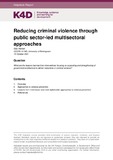| dc.contributor.author | Herbert, Sian | |
| dc.date.accessioned | 2022-05-09T10:49:07Z | |
| dc.date.available | 2022-05-09T10:49:07Z | |
| dc.date.issued | 2021-10-15 | |
| dc.identifier.citation | Herbert, S. (2021). Reducing criminal violence through public sector-led multisectoral approaches. K4D Helpdesk Report. Institute of Development Studies.DOI 10.19088/K4D.2022.043 | en |
| dc.identifier.uri | https://opendocs.ids.ac.uk/opendocs/handle/20.500.12413/17386 | |
| dc.description.abstract | The last decades have seen increased consensus for the need to understand and address violence through a public health approach, and a preventative approach, as embodied by Sustainable Development Goal (SDG) 16. This necessitates a multi-sector and multi-stakeholder approach, yet poor governance continues to threaten progress on this agenda.
Many policy approaches to urban violence tend to take an approach that is either
place-based; people-based; or behaviour-based and include a range of initiatives. The INSPIRE initiative is a key global response to tackling violence against women (VAW) and violence against children (VAC)
A multisector approach is needed to address the complexity and multifactorial origins of violence. Yet multisector engagement can complicate institutional responses due to different goals, concepts, instruments, etc. Increased collaboration and joined-up approaches across government departments have led to changes in institutions and approaches.
The literature base on violence prevention initiatives is varied and uneven across the different types of violence, e.g. with more literature available on interventions focussed on interpersonal and urban violence compared to organised crime-related violence. Evaluations are limited and face many methodological challenges (Cuesta & Alda, 2021) – e.g. the scale and complexity of violence limits the extent to which interventions can be rigorously evaluated or comparable, and most focus on interventions in the Global North. Most importantly, the literature base for this specific question – focussed on the wider institutional context and lessons for a multisectoral approach – is very limited, as most of the available literature focusses on lessons relating to the outcomes of the interventions. In line with the operational focus of this paper, this review draws mainly on practitioner and policy publications. The approaches, interventions, and lessons detailed below are illustrative and are not comprehensive of the many complex lessons relating to this broad area of programming. | en |
| dc.description.sponsorship | Foreign, Commonwealth and Development Office (FCDO) | en |
| dc.language.iso | en | en |
| dc.publisher | Institute of Development Studies | en |
| dc.relation.ispartofseries | K4D Helpdesk Report;1051 | |
| dc.rights.uri | https://www.nationalarchives.gov.uk/doc/open-government-licence/version/3/ | en |
| dc.subject | Security and Conflict | en |
| dc.title | Reducing Criminal Violence Through Public Sector-led Multisectoral Approaches | en |
| dc.type | Helpdesk | en |
| dc.rights.holder | © Crown copyright 2021 | en |
| dc.identifier.doi | 10.19088/K4D.2022.043 | |
| dcterms.dateAccepted | 2021-10 | |
| rioxxterms.funder | Default funder | en |
| rioxxterms.identifier.project | K4D | en |
| rioxxterms.version | VoR | en |
| rioxxterms.versionofrecord | 10.19088/K4D.2022.043 | en |
| rioxxterms.funder.project | 0986883a-6d0f-4bb8-9c46-5e0682934d65 | en |

